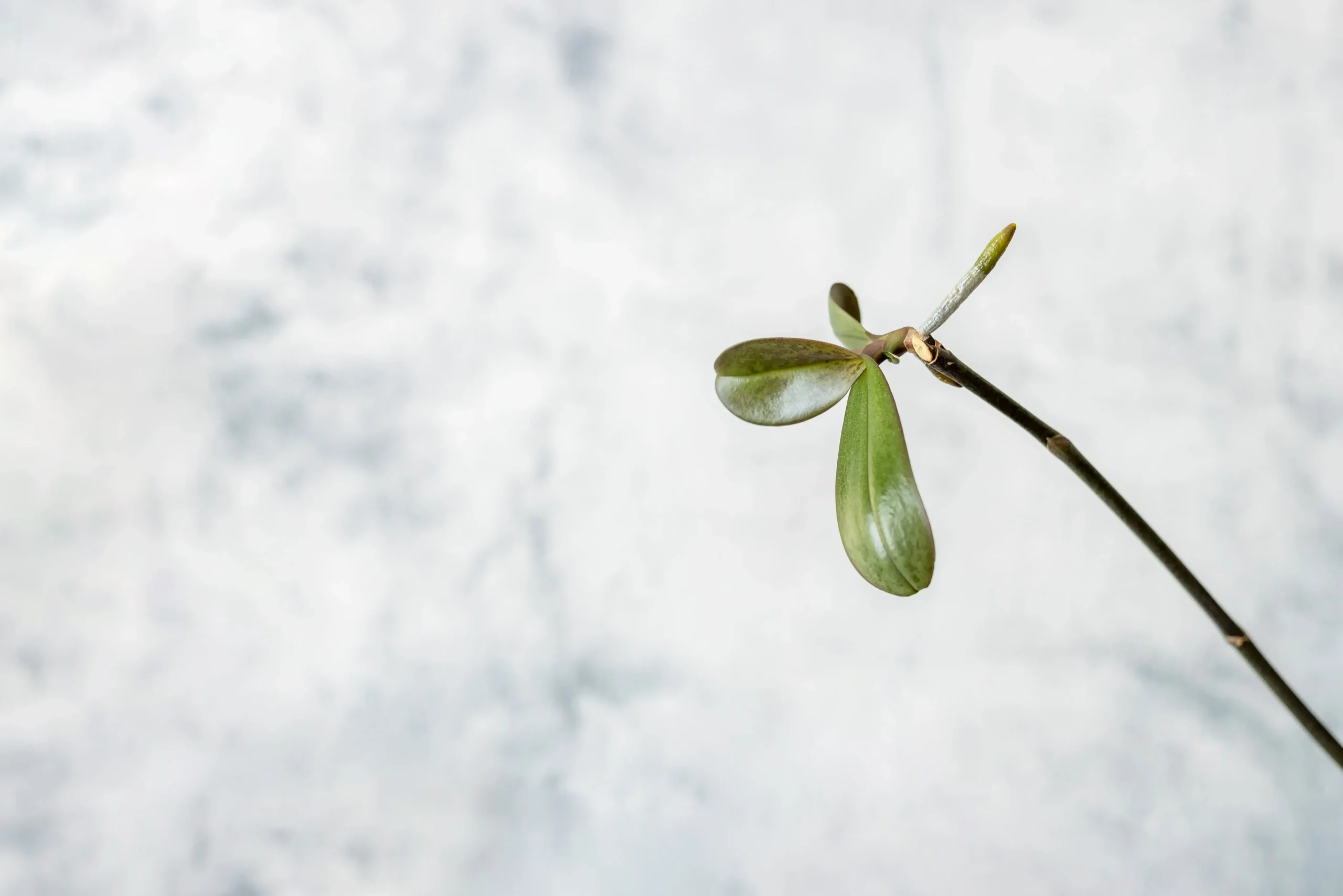Keikis are small plants produced by an orchid at the end of the bloom spike. The literal meaning of Keikis is “the little ones.’’ These baby plantlets typically appear under stress conditions on older shoots or blooming pseudobulbs.
It is the easiest way to propagate orchids, and the offspring is identical to the mother plant, giving the same foliage and flowers as the parent.
Some orchids are naturally prone to produce more keikis, while others may or may not develop them. Therefore, it was considered natural until “Keikis paste” gained popularity.
Table of Contents
What is Keiki Paste?
Orchids rarely produce keikis naturally, so keiki paste comes in to help the formation of keikis.
When keiki paste is applied to a plant’s nodes, it encourages the production of keikis and the growth of additional flowers or foliage. If you get a keiki or a stem is beyond your control, but it is a successful way to start new growth.
The primary ingredients of Keiki paste are growth hormones, carrier chemicals, and some vitamins.
- The active ingredient in keiki paste is cytokinin, mainly 6-BenzylAminoPurine (6-BAP), a plant hormone important for growth, cell division, and differentiation.
Cytokinin is the growth regulator, but not the rooting hormone. It is naturally produced in the meristems (root and shoot growth points) and transported to other parts. This hormone maintains the protein important for cell division and ultimately helps increase new cells.
Different types of synthetic cytokinins are also available in markets, and farmers use them to increase crop production, improve fruit quality, and reduce disease resistance. Remember, cytokinin is a chemical messenger that sends signals for new growth, primarily of shoot systems.
- The carrier ingredient is lanolin, which helps in the absorption and distribution of cytokinin. It also helps to protect and heal the plant wound.
- Cytokinin functionality improves when combined with other hormones, specifically auxins (indolebutyric acid, IBA). It plays a significant role in maintaining root and shoot points, stimulating nodule formation, and vascular development.
Monopodial vs. Sympodial Orchids
Understand the morphology of orchids before using Keiki paste as the application and results may vary depending on the type of orchid.
There are two types of orchids based on stem morphology:
- Monopodial Orchids (Single Stem Orchids): They grow vertically with a single upright stem, from which flowers and leaves emerge. Their nodes are located on the flowering stem. Therefore, the paste should be applied to the base of the stem to stimulate new growth from that point on. The most common monopodial orchids include Phalaenopsis (Moth Orchids), Vanda, Paphiopedilum, Angraecum, and Aerides.

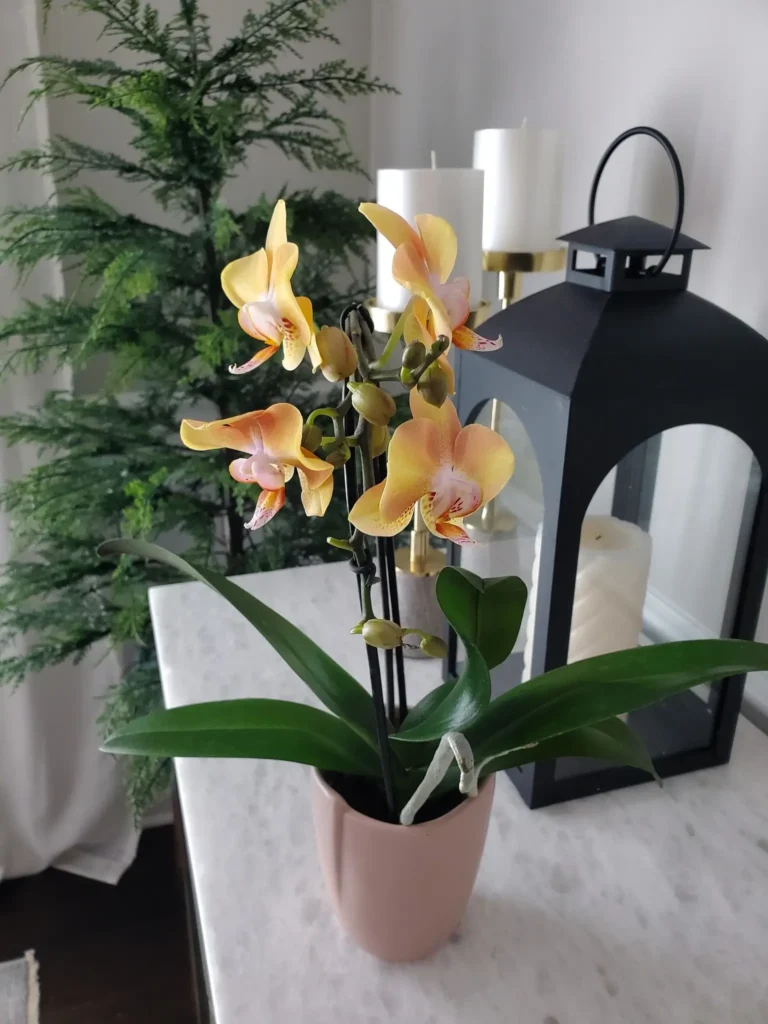
- Sympodial Orchids (Clumping Orchids): These orchids have pseudobulbs, with new shoots emerging from the base of the older ones. Each pseudobulb has its root system and flower spikes, which are replaced by new ones. So, apply Keiki paste to the nodes on the pseudobulb where you want new growth to sprout. Some sympodial orchids are Cattleya, Cymbidium, Dendrobium, and Miltonia.
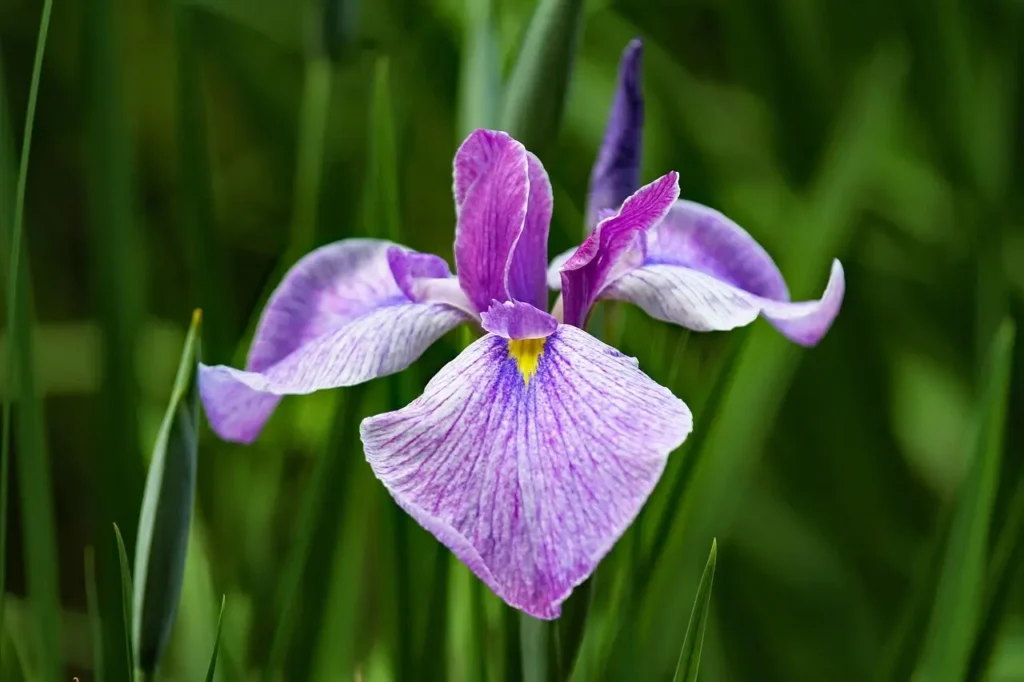
Keiki paste can also be helpful for sympodial orchids, especially those with large rhizomes like Cattleya. Although sympodial orchids can be propagated by division, keiki paste can help promote new growth on older, dormant parts of the rhizome.
How to Use Keiki Paste on Orchids
Keiki paste is applied directly to dormant nodes, typically one week after flowering ends. Use keiki paste on healthy, actively growing orchids. Avoid using it on orchids that are stressed, diseased, or dehydrated. A pro tip is to select the best color node to stimulate new growth from that point.
The best time to apply keiki paste is after the plant has lost its flowers. Avoid using it when the plant is developing a flower spike.
Steps to Apply Keiki Paste on Orchids
1. Select a Healthy Dormant Node: Find a dormant node on the flower spike. Find the nodes at the base of the pseudobulbs for sympodial orchids.
2. Remove the Bract: The node is often covered by a thin bract. Gently cut the node and remove the covering with tweezers to avoid damaging it. This step check that the hormones can interact with the plant cells.
3. Apply Keiki Paste: Use an applicator, wooden stick, or paintbrush, apply a small amount of the paste to the green part of the node. Don’t apply blobs of paste. Evenly spread the thin layer of Keiki paste so that the plant can absorb it well.
4. Monitor Growth: New growth will be visible after 3-4 weeks. The node becomes a Keiki or flower spike, depending upon the plant. Keikis will look like mini orchids with roots and leaves.
5. Remove and Pot the Keiki: Once the keiki has healthy roots (about 2-3 inches long), carefully cut it off and pot it.
Keiki Pastes That Actually Work
There is a lot of debate about the effectiveness of Keikis pastes. The results may vary, so I have seen mixed opinions about it. I have been using Keiki paste on Phalaenopsis and Dendrobium for some time, and most of my experiments have succeeded. So, it is not a magic product, but it is pretty effective.
My top two recommendations based on cloning effectiveness and growth rate improvement are:
1. Cloning Paste by Southside Plants
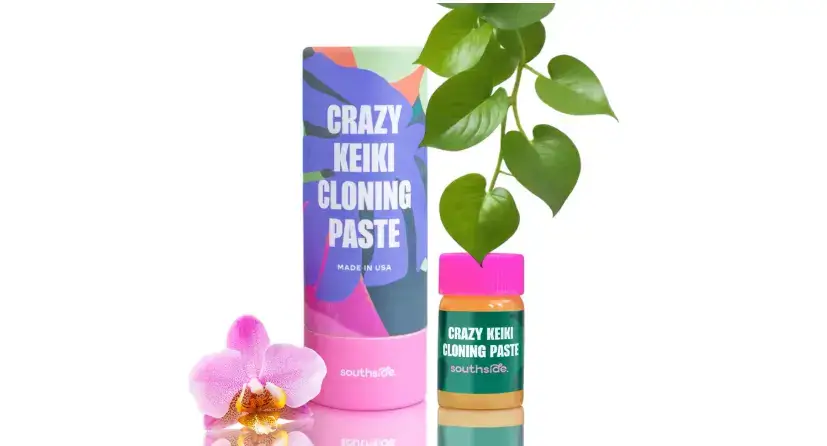
The paste comes in a small, resealable container and includes applicator sticks. I really like that it has a thick, Vaseline-like consistency, which makes it water-resistant. Therefore, you don’t need to apply the paste frequently. I used it on a Phalaenopsis orchid spike. At first, I was a little cautious, so I only selected one node to experiment on. But it’s a go-to product for me now.
The application is straightforward. I dabbed a small amount of paste on the node and waited. Don’t expect immediate changes at the start. Small bumps start forming at the treated node after 4 weeks. After 5 weeks, the Keiki became more pronounced, showing visible leaf growth.
I highly recommend it for propagating orchids or encouraging more blooms. Although it requires patience, the results speak for themselves. While the quantity is small, that’s fine, as you need a very small amount of paste. I think it’s a worthwhile investment for serious growers.
2. Berkland Keiki Paste

I have recently started using this one. It also has a thick and waxy consistency, which is great for the product to stay in place after watering. The paste comes with wooden applicators, but it is very sticky, so it is a little tricky to handle. I recommend using gloves or washing your hands immediately after applying it.
I applied the paste to several plants, including my Phals and a leggy pothos. It’s been about two months now, and tiny keikis started forming on the lower nodes of Phalaenopsis. As the plant decides what to grow, I noticed extra flower buds forming on another treated node.
For the Pothos, I observed new vines sprouting where I had bare patches. I applied a very small amount, and even after multiple applications, it was just a scratch on my jar. As the label claims, it’s enough for more than 100 nodes, so there’s still a long way to go.
My Experience with Keiki Paste? Does It Work?
Yes, it does. I have successfully grown Keikis, Phals, and dendrobiums, and sometimes use them to promote flowering. However, I am unsure about other varieties like Jewels and Vandas because I haven’t experimented with them. Here are my top findings that might benefit you:
Application Matters
Simply applying a large amount of paste may not work. I recommend lightly scratching the node before applying the paste, which will improve its absorption.
Some have succeeded without scoring, evenly distributing small amounts onto the axillary bud.
Growth Stimulation vs. Stress Management
A common mistake gardeners make is to use the Keiki paste on multiple nodes on a single plant. Activating multiple growth points at once can stress the plant. I recommend using Keiki paste on one node only, as you don’t know how a plant responds to it. Furthermore, activating more growth requires energy, which may stress out your plant and increase the risk of malformed growth.
I observed that applying the paste to one or two buds at a time ensures the plant can provide enough energy for new growth without sacrificing health.
Risks and Considerations
Applying too much paste can rot the bud, cause malformed growth, or doesn’t work at all. Keiki paste does not work on cuttings without a viable node, and some plants respond by producing aerial roots instead of new leaves.
Best Uses
Instead of Keikis, or bloom, I have seen some growers using it on bare stems to stimulate side shoots, and surprisingly, it works.
I recommend applying the Keiki paste on mature, healthy, and actively growing plants paired with a balanced fertilizer like K-Lite to get the desired results.
How Long Does It Take for a Keiki to Appear?
The initial growth is visible after 4-8 weeks. However, many factors affect the whole process, such as orchid health, environment, and cytokinin concentration. If the plant is a fast grower, the Keiki will also grow faster, and vice versa. To differentiate between a Keiki and a bloom, look closely. The flower spike resembles a closed fist, while the Keiki develops its tiny leaves first. Don’t disturb the new growth until the roots are visible.
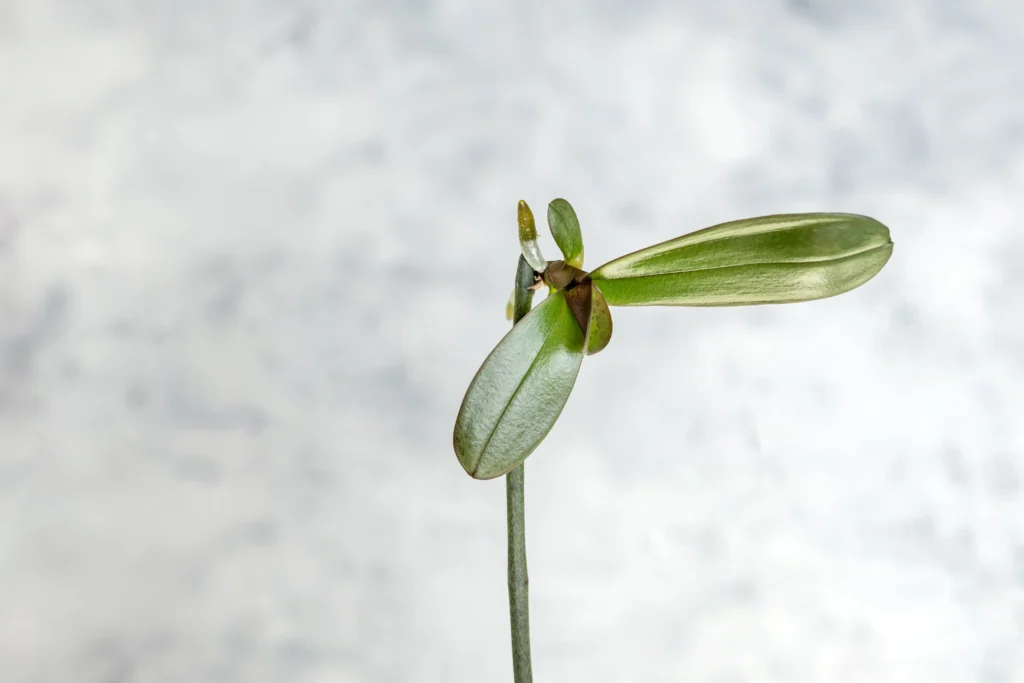
What If Your Orchid Grows Flowers Instead of Keikis?
I have seen on different forums that people are typically using keiki paste to get blooms rather than Keikis. Therefore, don’t panic if you get blooms instead of baby plantlets. It’s still a successful application. Keiki paste often results in more flowers rather than keikis. It is a privilege for commercial growers to use it to maximize blooms.
Tips to Care for Your New Keiki
- Keep the mother plant warm and maintain a 70°F temperature.
- Water weekly and use rain or distilled water.
- Fertilize the plant every two weeks after watering.
- Maintain the other conditions as per the orchid type.
You can allow the baby plant to grow with the parent, and they will both love it. Or, if you are removing it, pot it in the same container with the mother plant to easily adapt to the established rooting system while developing its own. Co-planting will give the plant a bushier look.
Can You Make Your Own Keiki Paste?
Although I have seen people making Keikis paste at home, I think commercially available products are better. I haven’t made it, but some growers use DIY recipes to create it to save some bucks.
DIY Keiki Paste Recipe
It consists mainly of two major ingredients: lanolin(a carrier that distributes the hormone evenly and protects the plant) and cytokinin (a growth hormone that encourages lateral bud and leaf growth), specifically benzyl amino purine (6-BAP).
Ingredients and Equipment:
- 3.5oz lanolin
- 0.1g – 0.4g 6-BAP powder
- Mask (to prevent inhalation of 6-BAP)
- Goggles
- Small glass jar, spoon, scale, bowl, or hot water bath
- Mortar and pestle (if 6-BAP is not finely ground)
Instructions:
- Wear gloves, a mask, and goggles before handling chemicals. Warm water in a bowl, ensuring that when you place the jar in it, it does not trip over. Avoid boiling or increasing the temperature of the water.
- Melt solid lanolin in a jar or container in the water bath. Let it cool for some time, do not add the BAP to hot lanolin.
- Grind and weigh the 6-BAP powder before mixing.
- Mix a precise amount of 6-BAP into melted lanolin until you get a homogenous mixture.
- Allow it to cool and store it in an airtight container.
My Preference
Commercial keiki pastes are prepared by experts in a sterilized, controlled environment. They contain optimized concentrations, additional vitamins for better success, and preservatives to prevent bacterial growth. Homemade paste may have inconsistent results due to difficulty measuring precise hormone ratios.
The DIY recipe created in your house does not have a long shelf life, and the product may deteriorate early compared to commercial ones. Signs of spoilage are foul odor and a change in color or texture of the paste. Discard the paste if you observe any of the above signs.
However, if you love experimenting, safety precautions are required for DIY. 6-BAP powder is toxic if inhaled, and it is a skin, eye, and lung irritant. Keiki Paste is inexpensive, so buying it will save time and effort.
FAQs
What Is Keiki Paste Made Of?
Many brands don’t disclose the complete ingredient list, but Keikis paste has two main ingredients: cytokinin, a plant growth hormone, and lanolin, a waxy base, along with some vitamins.
Does It Work On All Orchids?
Although Keiki Paste works on most orchids, its effectiveness may vary depending on the species. Jewel orchids are susceptible to growth hormones, as they burn their tissues. On the other hand, Ludisia and Phals may respond well.
When Should I Apply Keiki Paste?
The best time to apply Keiki paste to orchids is when they are healthy and actively growing, typically after or towards the end of their blooming cycle. Make sure the plant does not have any flowers or flower spikes, as these may stress the plant out.
Can Keiki Paste Harm My Plant?
It can harm a plant if applied when the orchid is stressed, sensitive to chemical-synthetic growth hormones, if applied excessively, or used on multiple nodes of a single orchid. It can divert the plant’s energy from other growth processes, like root development and foliage health. Don’t experiment on rare varieties.
Why Didn’t The Keiki Paste Work?
Possible reasons why Keiki paste does not work include selecting the wrong node, such as a dead or dried node, using the paste when the plant is stressed, or not growing actively, so it is unable to produce new growth at that time. Some plants are less prone to producing Keikis due to their genetics.
Does Keiki Paste Stop Roots From Growing?
Applying Keiki paste on plants recently undergoing stress or trauma will hinder root growth and promote top growth (leaves-shoot).
Is Keiki Paste The Same As Rooting Hormone?
No, keiki paste should not be confused with the rooting hormone. Keiki paste consists of cytokinin, a growth hormone that helps in cell division, specifically at the meristems, while the rooting hormone contains auxin, which encourages root growth.
Is Keiki Paste Toxic?
No, the ingredients in Keiki paste are considered safe for humans and pets. Lanolin is used in the majority of cosmetic products, so it does not pose any risks. The cytokinin hormone is not harmful, but that does not mean it’s okay to ingest it. Keep the non-food items out of the reach of pets and children.
How Long Does It Take For A Keiki To Grow Roots?
After applying your keiki paste to the node, wait for at least 4-8 weeks to observe new growth. Depending on the plant variety, environmental conditions, and the plant’s growth rate, a keiki can take a few weeks to a couple of months to develop roots.
Summing Up
Keiki paste is a valuable product for orchid growers as it allows the propagation of new plants identical to the mother plants. Moreover, it encourages more flowers. Better to use a commercial one with a long shelf life. With patience, proper application, and healthy plants, you’ll be well on your way to growing new keikis and enjoying the magic of plant cloning right from your windowsill.

